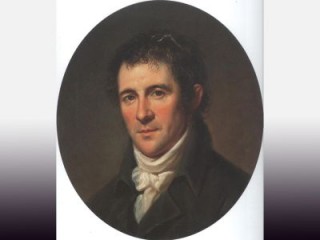
Benjamin Henry Latrobe biography
Date of birth : 1764-05-01
Date of death : 1830-09-03
Birthplace : West Yorkshire, England
Nationality : British
Category : Arhitecture and Engineering
Last modified : 2011-01-06
Credited as : Architect, ,
Benjamin Henry Latrobe, English-born American architect, was the first professionally trained architect to practice in the United States. He worked in a variety of styles.
Benjamin Henry Latrobe was born in England of Moravian parents. He was educated in England, France, and Germany, and as head draftsman in the office of the London architect Samuel Pepys Cockerell he participated in such large projects as the Admiralty Buildings in London. His coming to American was something of an accident; his young wife died, architectural commissions were few because of the Napoleonic Wars, and he had an inheritance to claim in Pennsylvania.
Latrobe arrived in Norfolk, Va., in 1796 and was soon recognized by Thomas Jefferson, George Washington, and other prominent people as the ablest architect on the American scene. For the rest of his life he had many commissions in every part of the country.
In his works Latrobe displayed an amazing versatility and command of every current idiom. He undertook engineering projects, from waterworks in Philadelphia and New Orleans to a dry dock for the first American "mothball fleet." He executed private houses, banks, exchanges, theaters, churches, Masonic halls, and Federal commissions— he gave the Capitol and the White House in Washington their polished forms. He did college buildings, lighthouses, tombstones, statue pedestals, and furniture. His houses varied from the geometric simplicity of "Adena" (Chillicothe, Ohio, 1805-1806) to the Adamesque-Federal elegance of Henry Clay's "Ashland" (Lexington, Ky., ca. 1812, later altered) to the Gothic style of "Sedgeley" (outside Philadelphia, ca. 1800).
On some public buildings—the Virginia Penitentiary in Richmond (1797) and the Center Station Pumping House in Philadelphia (1799), for instance—Latrobe worked in broad geometric forms expressive of utilitarian function inspired by Claude Nicolas Ledoux's rational classicism in France. On others, such as the Bank of Pennsylvania in Philadelphia (1798), where Latrobe ingeniously combined the first Greek revival portico in America with a Pantheon-like Roman dome, and the Custom House in New Orleans (1807-1809), he played with subtle spatial combinations of forms in the manner of Sir John Soane, whose English Regency elegance he undoubtedly knew.
But Latrobe also showed himself aware of and competent in the new 19th-century concept of architecture as the art of creating images of ideological conviction by means of historic styles eclectically borrowed for historical association. In 1808 he proposed a library for Congress to be built on the model of an Egyptian hypostyle hall, presumably in allusion to the wisdom of the ages kept therein. The furniture he designed for the White House (1809-1810) and the close approximation to a Greek Doric facade he executed for Pavilion X of the University of Virginia (ca. 1817) were appropriate because, as Latrobe explained in an Anniversary Oration before the Society of Artists in Philadelphia in 1811, a new Greece was developing "in the woods of America."
At the same time, Latrobe was introducing the Gothic style in designs for the Roman Catholic Cathedral in Baltimore (1805), Christ Church in Washington (1808), St. Paul's in Alexandria, Va. (ca. 1816), and the Bank of Philadelphia (1807; demolished). Of these, his plans for the Baltimore Cathedral were perhaps the most important historically, for more than usual symbolic significance attached to this building. As the seat of what had once been the governing Catholic diocese of all the English provinces, it was a reminder of the important role that Catholics had played in building America. Latrobe submitted two sets of plans for the Baltimore Cathedral, one in Gothic style, the other an adaptation of the Pantheon in Rome. In discussions of their relative merits, hardly any weight was put on esthetic value; the whole question was whether Gothic, as symbolic of a Church "the same yesterday, today, and forever," was more suitable than Roman. Roman won out simply because Gothic could not match its combination of "patriotic American" and "loyal Roman Catholic" symbolism.
But Latrobe was too fundamentally versatile ever to accept the Greek revival symbolism unreservedly. Hence his disagreement with Jefferson over the dome of the House of Representatives, Jefferson wanting (and getting, in the original version) a grand symbolic shape, Latrobe advocating a more practical functional construction, and reverting to it when called back to rebuild the destroyed dome in 1815. Hence his failure in the Second Bank of the United States Competition in 1818, which William Strickland won with a "pure Grecian" design. This led to Latrobe's departure for New Orleans, where he died 2 years later.
The standard works on Latrobe are Talbot F. Hamlin's Greek Revival Architecture in America (1944) and Benjamin Henry Latrobe (1955).
















